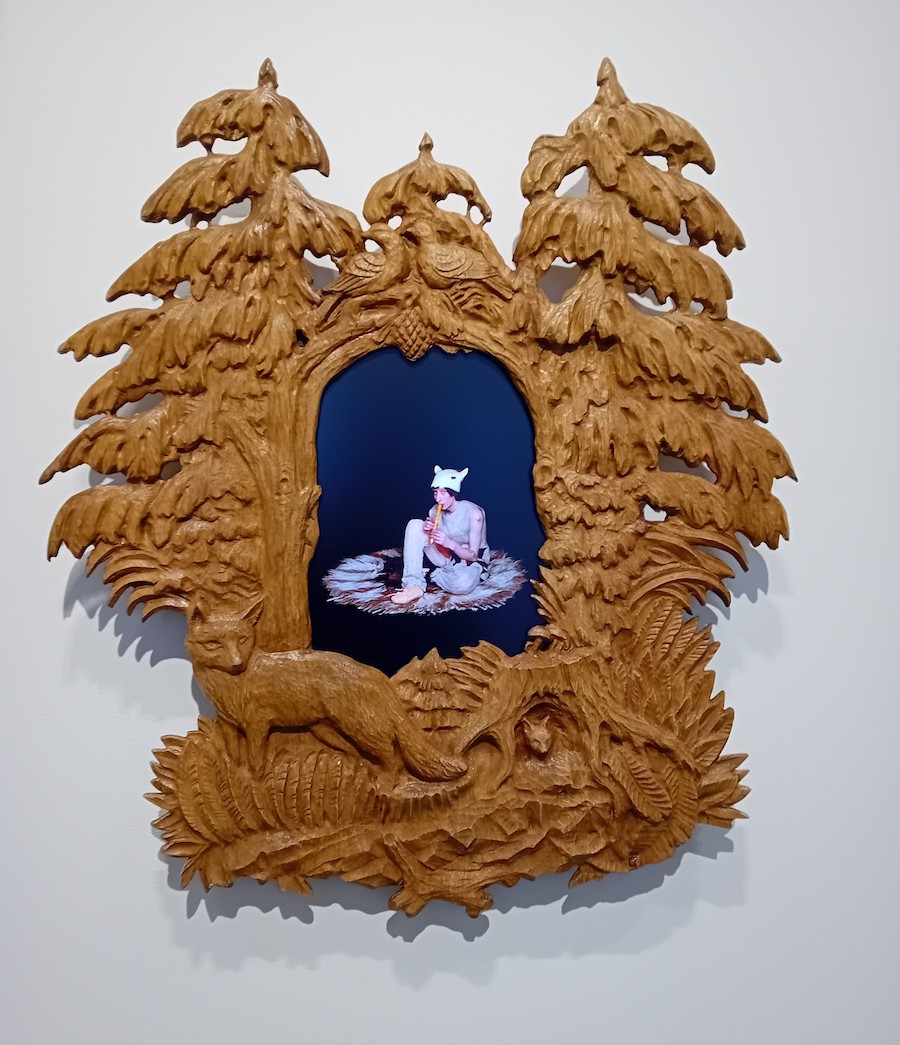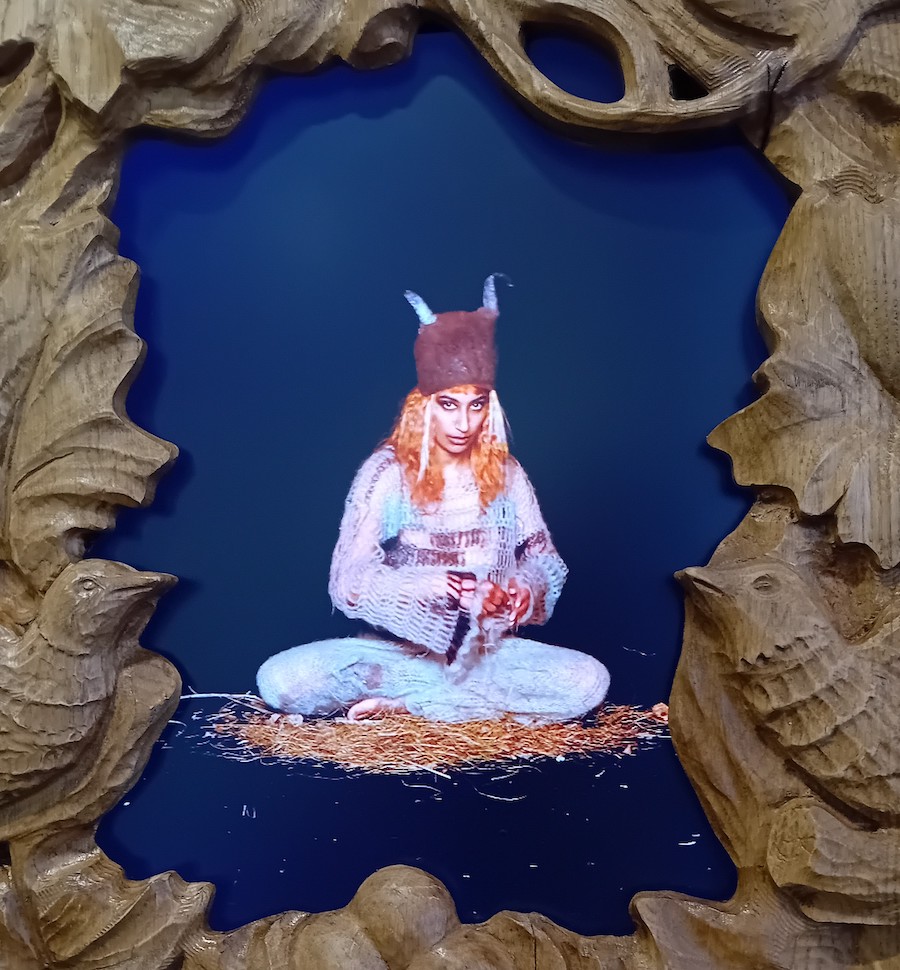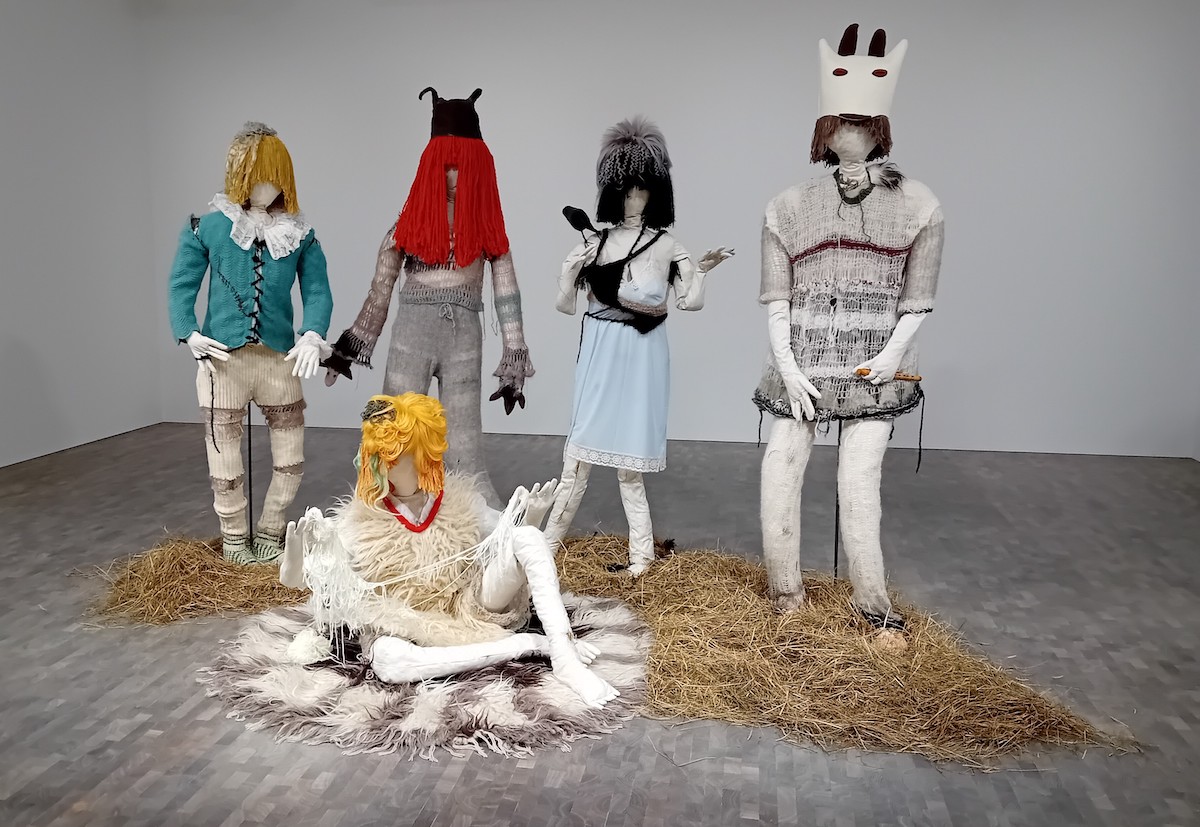Multi-media artist Paulina Olowska has said that what fascinates her the most is ‘the non-linear history hidden beneath the surface’ and that growing up in the 1980’s ‘amid two opposing visions and mentalities in socialist Poland and the United States’ significantly shaped her artistic outlook. That has led her to engage with the political and social histories of Eastern Europe and America – most often in the context of female perspectives and narratives – and to investigate how they feel in the present by revisiting them through her work. Her new show ‘Squelchy Garden Mules and Mamunas’ recasts her interests in the context of natural landscapes and Slavic myths. It incorporates work developed for her major solo show ‘Her Hauntology’ at Kistefos Museum in Norway, and fills the whole of Pace’s extensive London gallery until January 6.
You show five videos of ‘Mamunas’ and ‘Garden Mules’? What are they?
A mamuna, literally translated from Polish as strangewife, is a female swamp demon closely associated with rivers, streams, and thickets. They appear in various forms in folk stories across the Slavic region, and contrast interestingly with the mythologies of Christianity which we all know. The ‘Garden Mule’ is the white little boy with horns: that name came out of my discussions with curator Kate Smith when we were filming in Norway. After telling her what mamunas are, I said: ‘let’s make up some other names of deities from the forest’, and she suggested ‘garden mules’ – it sounded good and I like it that the mule lives between animals, being half-horse, half-donkey, so it’s a metaphorical title.

Paulina Olowska: detail from ‘Squelchy Garden Mules and Mamunas’, 2023 – five channel framed video installation, dimensions variable
So we have four mamunas and the garden mule. How have you presented them?
Making a show in the middle of the woods in Norway, was as inspiring as running a foundation (Artist House Kadenówka Foundation) in the middle of the countryside in Poland. Both are surprising and unexpected locations to present contemporary art. To amplify the spirit of the Museum in Norway, in what is called ‘The Twist’ – a twisted building over a river – I decided to add more fake trees inside and place the Mamunas videos in the hollows of them. At Pace they are on screens set in carved frames like woodland hollows. I love making amplifications of spaces, as in the performance The Mother in Tate Modern in 2015, where I created set of a Huculian hut with paintings by Pablo Picasso , Meredith Frampton and Henri Matisse.

Paulina Olowska: ‘Dziewannas (After Branislav Šimončík)’, 2023 – oil on canvas, 310 x 209 cm
Several large paintings feature the same cast, but others – such as ‘Dziewannas (After Branislav Šimončík)’ don’t. Why is that?
Most of the works come from my photoshoot and films made in Norway, but I wanted to take this show beyond just those ideas. So others, like Cepelia, Dziewannas or Glisne are paintings based on found photography that I reappropriated with a more personal narratives. For example I found these amazing portraits of a young androgynist couple on an oak tree in recent Vogue Czech shoot by Bransilav Simoncik. I present them as Dziewannas, the wood demons, as archers guarding the forest – the arrows are my addition.
You show your studies for the costumes in which the mamunas performed, and also puppets wearing the costumes. I guess that fits in with your long-standing interest in fashion?
Yes, I love to connect art with fashion, and for two years I worked as artistic director of Polish Art Vogue: I did photoshoots, met models, saw the industry. A lot of my work comes with the belief that fashion is a metaphor for personal and social revolution. Pose and hair style become symbolic. And the parallels and differences from art were fascinating for me. Fashion deals with theatricality through colour, form, space, people… I started to look at fashion photographer’s portfolios and find the images which resonate with me. I often create outfits for my models, as in the downstairs space of Pace, where I include the outfits from the photo session in Norway.

Paulina Olowska: detail from ‘Squelchy Garden Mules and Mamunas’, 2023 – five channel framed video installation, dimensions variable
Who are the mamunas?
Mine are mystic creative professionals (laughs)… While at Vogue I met a lot of incredible people working in fashion. One of them was Lou, from ‘Let it go’ agency in Amsterdam. Lou was managing talents such as Amy Morgan, Rick Geene, Sayuri Chetty, Kamil Sznajder and Yasmin El Yassini…. They are my muses – my mamunas and mules. They’re all in their twenties, they do part time studying while modelling or being actors or musicians. Filming them was great fun.
They seem more mischievous than demonic?
One thing about demons is that we’re scared of them, and their power, so if they’re too friendly it’s not good! But what is true about Slavic goddesses – as well as Hindu goddesses – is that they have their yin / yang virtues, their either / or, the friendly side covering the more evil side.

Paulina Olowska: ‘Strzygla with Mamunas’, 2023 – oil on canvas, 260 x 333 cm
How were the paintings of the five characters – such as ‘Strzygla with Mamunas’ – made?
The idea was we met to make films in the tree hollows, but I grabbed Kacper Kasprzyk, the photographer, and Monika Kucel, who helped me make the outfits, and we had a photoshoot day outside. We did plein air photos, middle of the winter with Mamunas exploring the rivers and forests of Jevneker village in Norway. It was spontaneous – and I’ve found that spontaneity works well for me. I was looking at them throughout the year, left them on my studio wall, I thought ‘they are excellent, I want to make paintings from them’. Then I took the time to explore in my painterly head how to work with paint gesture and weave in the painting the expression of nature. And I liked the connection with how back in the day painters had an entourage – models, assistants, students – always this aspect of the artist being present with others – now I feel painters are more solo in the studio, so the idea of recreating images from my tableaus was special. And the mamunas have come to the openings…
Why not show the photographs?
Perhaps I will get there, I am interested in exploring the language of photography, but at the moment when I reflect on the photographs, I feel a desire to transform them into a deeper visual language, echoing the moment. Photography is a split second while painting is a duration, a constant re-entrance into the scene, a mind game, a kind of head projection combined with the alchemy of the process. A painting emerges from months of being with the image in the studio – I really like painting as a method of mediation. My aim is to achieve what Bernard Frize, one of my teachers, called the ‘economy of painting’ – how to represent an image with the most persuasion in the gesture. In this show, inspired by Norway and seeing the divine nature painting in its new National Museum, there is a new direction for me in the representation of nature. I like to have question in mind when I make a show, and here it was not so much Slavic folk art as ‘how do we represent the landscape as a painter?’ And so with every image I moved between different approaches and techniques.
Your previous work has often reinterpreted historic female muses for modern times, and you’ve spoken about how the past haunts the present. Could you say something about that and how it applies in this show?
Here I’m looking to research the missing links to modernity not through historic muses, but through folk art. That’s an alternative setting for the theory which dear Mark Fisher developed to apply to music, in which elements from the past persist in the manner of a ghost. His approach made sense of my take on feminism – can you make a new future for feminism through figures from history coming back to you, by re-envisaging them for what they can give us now? That’s why my book of the Norwegian show is called ‘Her Hauntology’ – as it’s my take on it.
Top Photo: Paulina Olowska: ‘Squelchy Garden Mules and Mamunas’ Costumes’, 2023 – costumes, wigs and mannequins – dimensions variable
Paulina Olowska: ‘Squelchy Garden Mules and Mamunas’ runs Nov 22, 2023 – Jan 6, 2024 at Pace Gallery, 5 Hanover Square, London

